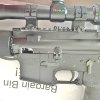pert near
Member
Like a lot of shooters, I'm enjoying the bargains that keep popping up on AR-15 parts. A good deal on barrels from one place & a good deal on bolts or BCG's from another place. Mix & match parts & save a ton of money!...LOL
But only on the more expensive barrels are bolts pre-check for headspace to your barrel if bought at the same time. I've check on a set of gages & a go, no-go, field would run about $100. There goes any savings. Where I live, going to a gunsmith for a headspace check is not easy or free. Is there another way to check for normal headspace using a sized case & a shim or some other method? Perhaps expand the neck & size to a crush fit, single fire, then measure case dimensions? Not sure if that would work & what dimensions to look for(?)
Just want to check for safety & assure all is within acceptable tolerances.
TIA for your comments & suggestions.
But only on the more expensive barrels are bolts pre-check for headspace to your barrel if bought at the same time. I've check on a set of gages & a go, no-go, field would run about $100. There goes any savings. Where I live, going to a gunsmith for a headspace check is not easy or free. Is there another way to check for normal headspace using a sized case & a shim or some other method? Perhaps expand the neck & size to a crush fit, single fire, then measure case dimensions? Not sure if that would work & what dimensions to look for(?)
Just want to check for safety & assure all is within acceptable tolerances.
TIA for your comments & suggestions.





